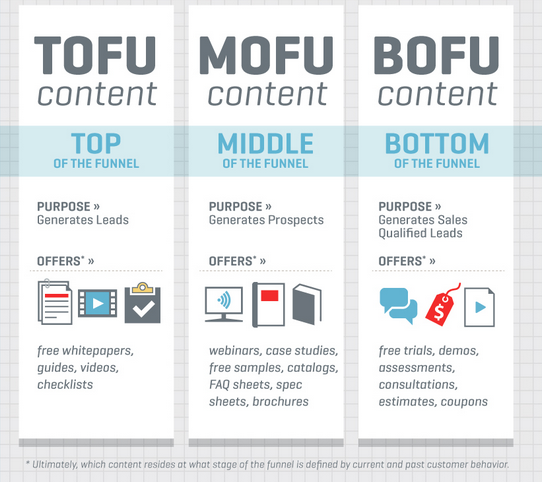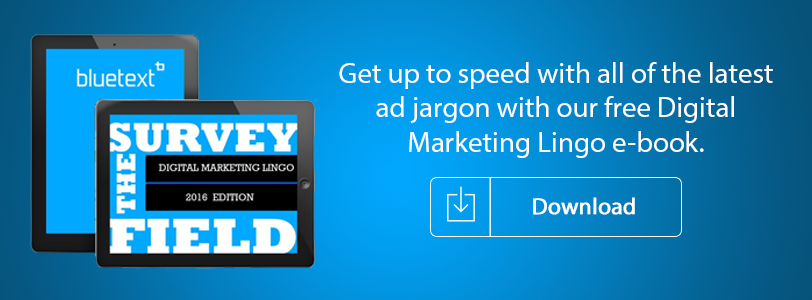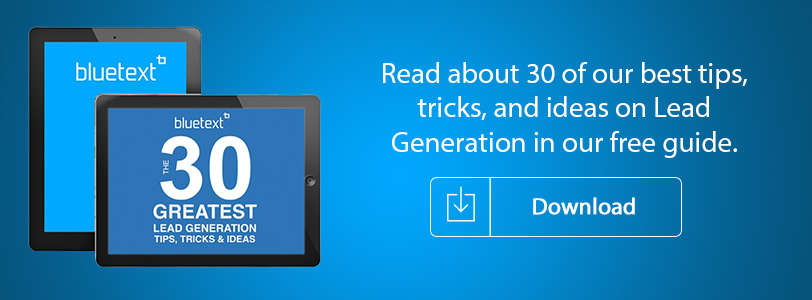As companies mature and think about how to take their business to the next level, invariably one of the toughest questions to answer is when is the right time to hire a marketing agency. Every company is different. As one of the top marketing agencies in Washington, Bluetext meets with companies of all shapes and sizes, and it is safe to say has seen it all. From the CFO who is dabbling in marketing to the head of business development to the person who just graduated last week, companies tackle marketing in different ways. So when someone asks “when the right time to hire a marketing agency is?” I pulled together some telltale signs that would suggest it is time to call in the professionals.
- The only money you are spending to get your name out there is the same industry tradeshow you have been attending for years, and you only go because “everyone goes.” I would be willing to bet that the money spent on that show could be spent on some much more effective tactics
- When someone says that they went to your website and has no idea what you do. This is a problem. You need clarity. You need a digital platform that delivers for your business. Prospects need 6-7 touches as a minimum before they want to engage with your company. The message, design and impact of your website needs to be clear and differentiated. If not then it is time to call a top digital marketing agency.
- You have no plan. How do you expect to grow a business with no marketing plan? Too many times we hear people say that they need to get around to focusing on marketing. That is likely a sign that it is too late. If you are selling a B2B product, a b2b marketing agency should be able to help you create a plan, determine the resources required to execute it, and then help deliver results with impact.
- You think of marketing and business development as the same department…enough said.
- You have to pinch to view your website on your phone…enough said.
- You are constantly looking at your competitors and talking about how great a job they are doing with their brand and positioning. We hear this all the time.
- Every vendor that calls with a marketing idea sounds like a smart plan. A good b2b marketing agency can not only help you craft and execute a plan, but also help you sort through all of the opportunities that exist for promotion and help you point your arrows in the right direction.
So there you have it. Seven signs that it is time to hire a marketing agency. I am sure that this list can go on and on. Please share other thoughts in the comments zone and I will update the list accordingly. And if you don’t know what to do, give us a call. We have worked with companies across many industries to tackle many different marketing challenges to help them take their business to the next level.
When people ask me about Bluetext, I often find myself calling us of the region’s top B2B marketing firms. We work with world class global enterprises. We are on the cutting edge of branding trends and focused on leveraging emerging marketing channels. And we have a world class team of people focused on delivering great results for our clients. So here is my take on what makes us one of the top B2B marketing firms:
- A top B2B marketing firm works across a wide variety of industries. In my view, focusing on just a few industries can be limiting and lead to tired tactics. Instead, taking the learnings from some industries and applying them into adjacent markets can be valuable to clients.
- A top B2B marketing firm can tackle a wide variety of marketing assignments, delivering integrated solutions for clients. Clients like integrated service offerings. They like to work with clients who create a strategy then are able to roll it out via many channels.
- A top B2B marketing firm is working at the forefront of emerging delivery channels. See our recent work for Varonis at bluetext.com/varonis
- A top B2B marketing firm gives guidance versus simply taking orders. Challenging assumptions, doing things differently, and looking at ideas through different lenses can be incredibly valuable.
- A top B2B marketing firm starts with goals versus focusing on channels. Understanding where a client wants to go before deciding how to get there can be quite valuable.
- A top B2B marketing firm should have a seat at the table with you during key strategic meetings.
- A top B2B marketing firm should push your internal team to think beyond traditional channels and programs to reach prospects in new and unique ways.
- A top B2B marketing firm is part of the community and recognized for its great work
- A top B2B marketing firm is able to adjust strategies mid-course.
- A top B2B marketing has a client roster that you immediately recognize.
So that is my list. That is how I define a top B2B marketing firm. What did I miss? Please share other ideas and I can update the post in the future. And for more insights on B2B marketing, reach out to Bluetext today:

Attention all you marketers out there…ever sat in a meeting not wanting to raise your hand to ask someone for clarification on what they mean? Concerned that your colleagues or manager will think less of you? Gearing up for your next marketing campaign and need to include some new thinking?
Let’s face it – you are not alone. No one wants to be that person who raises their hand in those situations.
The world of digital marketing is moving very fast with new terms and concepts emerging everyday. From SERP to lead scoring to SEO to responsive design, it is getting harder to keep up.
If you are p
As most anybody reading this post already knows, the marketing challenges faced by B2B organizations in an increasingly content driven social landscape, require vastly different social marketing strategies and technologies than B2C companies. The more B2B marketers invest time, money and resources in the creation and distribution of premium content, the more they are under pressure to deliver social media ROI. And as most social platforms continue to change the rules of engagement, I thought it might be helpful to share a few insights on what B2B marketers can control to improve the effectiveness of their social presence to drive greater levels of awareness, engagement and demand.
Employee Activation
Because marketing departments in mid-market and enterprise level organizations are often outnumbered by their sales department brethren by at least 10 to 1 — they are looking for new and innovative ways to motivate sales organizations and employees alike to start being active social advocates in their own brand’s social ecosystem.
The good news is that new social marketing technologies enable corporate marketing to push messages down to individual reps who can then share the social content, become thought leaders and help build brand awareness in places like LinkedIn where they can now expose their entire network to new and relevant content to grow pipeline – their pipeline – and once they see that start to work for them they will become your biggest advocates.
Social Advertising
As social networks continue to manipulate their hidden algorithms to downgrade organic promotional posts at the same time they upgrade sponsored content – paid social promotion is becoming a growing and necessary channel for brands who want to stay visible and maintain their social reach.
Paid social media offers a wide range of valuable targeting options, allowing B2B marketers to hyper target an audience with rich and contextually relevant content across a wide range of emerging social platforms. However, many of these platforms have self-service interfaces available to launch paid social ads that might appear easy to use, but are often not leveraged or used properly by the brand owner.
For this reason, we recommend investing considerable time testing and analyzing social ad performance to stay in control of ROI. And while we recommend to our clients that they continue to maintain their paid search budget, we are seeing more and more of that being directed towards the increasing demand for content development that’s necessary to feed the social marketing beast – paid or otherwise.
Social Mobilization
Most B2B marketers use a multichannel social content distribution strategy, and therefore spend more than half their annual marketing budget on the development and production of content. The problem we are seeing is that all of that rich, premium content is increasingly being consumed on mobile devices – yet not being fully optimized for the mobile user.
B2B social engagement is now almost entirely mobile – with more than 75% of Facebook, Twitter and LinkedIn users accessing the social network via mobile – brands have the opportunity to leverage social channels quickly get their messages out to their customers and prospects.
The key to leveraging mobile for B2B social marketing isn’t just in it being presentable in a mobile accessible format – in needs to be easily sharable with share buttons and direct links that connect users to your website and other online properties to drive engagement, demand and measurable ROI.
The marketing and communications business is at a bewildering junction, with two simultaneous models vying for brains and assets. Most marketing campaigns look at personas of their buyers and determine what is the best path to the promise land.
Bottom-up marketing is a concept with no single definition, but a few distinct components that set it apart from traditional top-down marketing strategies. Unlike traditional marketing, where executives create a marketing plan and a strategy to promote a company’s products and services, bottom-up marketing is mainly driven by the employees of a company. Employees recognize one specific customer need the company can meet and create a marketing strategy around that single idea.
A great example is Dropbox. Dropbox rose to $10 Billion valuation through its connection with the end user. Dropbox focused on providing the masses of end users (both personal and professional) a block of cloud storage that elegantly and brilliantly stayed synchronized on your local hard drive and your collaborative peers hard drives. Dropbox didn’t sell the CFO on cost benefits and the CTO on the power of the cloud. Dropbox simply delivered a great service with a viral approach to a roll out that created an ever growing desire for more and more storage in the cloud. In the end so many businesses had hundreds and thousands of BYOS (bring your own storage) and they needed to take control of this corporate intellectual property, and reached out to Dropbox for the suite of tools and administration to make managing the cloud instances so much more manageable, secure, and scale-able.
The top-down marketing plan contains four principal sections: situation analysis, marketing objectives, marketing strategy, and tactics. A company’s marketing objectives should be logical deductions from an analysis of its current situation, its prediction of future trends, and its understanding of corporate objectives. In the end, a top down marketing approach focuses on the top executive personas most often. The constituent who controls the purse strings. All SaaS and Enterprise technology companies are always looking for the high and mighty inside an enterprise that has the power to sign on the dotted line. Top down marketing focuses its message and offers so they should relate to the needs of specific target markets and specify sales objectives. Marketing-target objectives should be specific, quantitative, and realistic. The messaging of a top down approach often caters to the fears and dreams of that influential executive.
A great example of top-down marketing is the hyper growth industry of cyber-security. Every executive fears waking up to their employer’s brand on the headlines of major media outlets next to the word breach or hacked. Years and years of customer loyalty and brand preference can be washed away overnight. Cyber security companies are preying on these executives with a top down marketing approach that strikes fear into their hearts and minds and forces them to strike the check and implement countless solutions to help them sleep easy at night as they try to appease key constituencies including public markets.
Does your business ever wonder how to harness its precious marketing and communications budget to achieve its short and long term goals? Contact Bluetext. We are a top marketing agency that delivers results whether your campaign is focused top down or bottom up. Let us use our proprietary methodologies to define the right method, and then develop the campaigns, platforms, and content assets to knock the cover off the ball.

Time to Write My Blog…I Wrote My Blog…Time to Write My Blog
Remember the iconic Dunkin Donuts campaign from the early 80s featuring Fred the Baker?
What a classic campaign. 30 years later the lessons we can learn from Fred are relevant and applicable to modern content market.
It is hard….It is time consuming…but it can really pay off when done right. In my estimation a disciplined approach to blogging and content marketing can be a relatively low cost way of tilting the playing field for your products or services.
We have built one of the strongest content marketing practices in D.C. by working with our clients to create aggressive, consistent content marketing campaigns that ensure they have a strong presence across the web with their key audiences. We create quarterly editorial calendars that align with key company and product milestones, as well as industry events where we can help amplify messages. We instill content marketing into the DNA of our clients so that they can experience the benefits of a disciplined approach.
Content marketing, however, is not something you can just set and forget. It takes care and nurturing. It takes discipline and an entire team effort. And it takes some creativity.
So the next time someone says they don’t have time to write a blog or are too busy, tell them to give me a call. We can share war stories and I can show them significant results. I think it will make them think twice and find that extra 30 minutes each week.
We have all been there. The requirements start stacking from all areas of the enterprise and the politics are thick. Companies are ignoring some white lies they are preaching and it is impacting a major driver that can impact your business….THE LOAD TIME OF YOUR RESPONSIVE OR MOBILE-OPTIMIZED WEBSITE.
WHITE LIE 1: “Just throw that 3rd party code snippet in the header”
Technical Saying: Minimize HTTP requests
What this means:
The quickest way to improve site mobile speed is to simplify your design.
- Streamline the number of elements on your page.
- Use CSS instead of images whenever possible.
- Combine multiple style sheets into one.
And more. Contact us if you would like an SEO assessment.
WHITE LIE 2: “Servers are all the same, it’s the cloud, ya know….right?
Technical Saying: Reduce server response time
What this means:
Your target is a server response time of less than 200ms (milliseconds). Bluetext recommends using a web application monitoring solution and checking for bottlenecks in performance. Contact us if you would like help measuring this.
WHITE LIE 3: “You don’t need compression with these fat pipes we have now”
Technical Saying: Enable compression and Optimize Images
What this means:
Large pages (which is what you could have if you’re creating high-quality content) are often 100kb and up. As a result, they’re bulky and slow to download. The best way to speed their load time is to zip them via a technique called compression. Compression reduces the bandwidth of your pages, thereby reducing HTTP response. You do this with a tool called Gzip. Oversized images take longer to load, so it’s important that you keep your images as small as possible.
WHITE LIE 4: Just throw a redirect on that problem…
Technical issue: Reduce redirects
What this means:
Redirects create additional HTTP requests and increase load time, so you want to keep them to a minimum. Considering redirecting your digital business to another agency? Contact Bluetext
WHITE LIE 5: “As we co-develop just throw the JavaScript up top”
Technical issue: Anchor pages with JavaScript vs Leading with JS
You want to place all your JavaScript at the BOTTOM of the page. This will optimize the perceived latency because as the page is loaded it stops upon encountering JavaScript. Putting scripts at the bottom allows the user interface to display before the JavaScript is loaded.
In the crowded and highly-competitive non-profit market, how do you differentiate your brand from your competitors?
While you’re thinking about how to stand out from the crowd, download a poster from our Adult Coloring Book that you can bring to life, and let Bluetext solve your bigger marketing challenges.
Download our Adult Coloring Book here!
Today’s landscape requires the need for constant database care and feeding…smart marketing campaigns, hyper targeted, very personalized, with highly engaging and rich creative presentation. Spray and pray marketing tactics have not worked for quite some time, and just trying to mimic the new hot buzz wordy marketing approach doesn’t also pay off as well as a thoughtful, disciplined and collaborative developed marketing strategy between a client and its marketing agency. So where does the” certified” and the “vegetarian” come in?
Vegetarian Marketers love TOFU. That’s their meat!

What’s TOFU?
Top of Funnel focused marketing activities.
Or better defined.
Good top of the funnel content marketing serves to commence a relationship (by way of opt-in) with a prospect visiting your site who otherwise might leave without making contact
Here are the key questions you should ask when putting together top of the funnel content.
- Does this intersect my prospects’ information journey at the right point?
- Does this look to take control of the information journey thereafter?
- Is this too obviously marketing?
- Have I considered what else I’ll back up this content with?
Why TOFU (Top of Funnel)?
There is no middle of the funnel or bottom of the funnel without the top of the sales funnel. The challenges brands experience in the middle of the funnel usually fall into one of two areas. The first area is non-opportunities. These are the “deals” that aren’t qualified opportunities at all. The second group is stalled opportunities. These opportunities are usually missing some of the commitments necessary to move them forward internally. The end of the funnel problems are usually around capturing value. But top of the funnel problems are far trickier. Think about how a funnel works. If you feed it in dribs and drabs you get dribs and drabs out of the other end. But if you keep a nice steady stream pouring into the funnel, you get a nice steady stream out of the skinny end.
Make a long story short. Worry first—and most—about the top of the sales funnel.

Now for the “certified” part of the equation
Bluetext works with many marketing automation and CRM systems, including Eloqua, Hubpost, Marketo, Pardot, and Salesforce – integrating, configuring, pushing creative through them, optimizing with them. These tools are the personalization marketing brain and the central data hub of value that all of our blood, sweat and tears deliver for our clients every day.
Bluetext is proud to announce we have expanded our credentials by being named a certified Hubspot agency.

Why work with an agency that has certified credentials versus a lot of lip service?
There are a lot of agencies that offer marketing automation services, but not all of them have the appropriate certifications. For organizations looking to partner with an agency to help them with their marketing automation readiness and implementation it is important to verify that an agency has the expertise to do so. A HubSpot Certified Agency Partner provides validation of the depth of an agency’s inbound expertise.
Bluetext delivers innovative content marketing campaigns for many consumer brands like Google, WeatherBug and SoundExchange. Contact Bluetext to learn how we can build your sales funnel with innovative digital content marketing services.
Sometimes it seems as if marketers are speaking their own language when you try to engage them in a Virtual Reality project to support your marketing, branding, or communications goals. From HMD to FOV to Judder, Virtual Reality jargon can be confusing. Whether a Google Cardboard project for your campaign or a high-end Oculus Rift project for a special event, it requires a solid collection of new terminology specific to VR technology. To help demystify some of the most commonly used Virtual Reality terminology so you can have a savvy discussion with your in-house engineers, agency folks or freelance consultants, we’ve put together this VR glossary.



